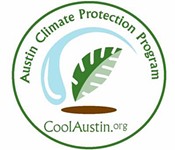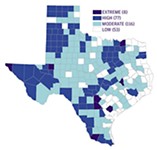Cool City: The Leffingwell Lens
One council member's view of the Austin Climate Protection Plan
By Katherine Gregor, Fri., Aug. 31, 2007
It's been six months now since the City Council unanimously adopted the Austin Climate Protection Plan. Conceptually, it's perhaps the most aggressive and well-rounded local program to fight global warming in the U.S. The plan's initial focus is to reduce greenhouse-gas emissions from within – meaning all city facilities, vehicles, and operations. Goal: Transform the municipality into a 100% carbon-neutral organization by 2020. But is the plan starting to make a difference at City Hall?
To get a sense of how such a big mission translates (or not) into each tiny day-to-day decision at City Hall, we visited with Council Member Lee Leffingwell. Addressing climate change by significantly reducing carbon dioxide and other greenhouse gases (GHG) is a daunting challenge for any city, he agreed, because it requires such a comprehensive rethinking of the way we live. "You have to become committed to looking at everything that comes in front of you through the climate-protection lens," he explained. Leffingwell's pragmatic approach to environmental issues earned him the 2006 Conservationist of the Year award from the Texas chapter of the American Water Works Association, which represents public and for-profit water-service providers. But how does that shade of green translate to climate protection?
To provide a snapshot, Leffingwell and his aide Andy Morman ticked through a list of council initiatives they've been working on and assessed how each project lends itself to climate-protection opportunities.
Water Conservation
Leffingwell noted that the Austin Water Utility is Austin Energy's single most energy-sucking client. In pushing for water conservation, Leffingwell sees global warming as one more reason why it's good city policy.
"Any savings in water use, treatment, and pumping means big energy savings," Leffingwell explained. "That translates to a lot of CO2." Drawing on the recommendations of the Water Conservation Task Force, the city has set a 10-year goal of reducing water consumption by 10%, which would save 32 million gallons per peak-use day. That savings, in turn, translates to preventing 19,000 tons of GHG emissions, or 38,000 pounds of CO2, from entering the atmosphere, Leffingwell said. Something else that would help: new, more energy-efficient water pumps.
He's proud that the national Water Works group is promoting the Austin plan as a template model for other cities. That level of backing could help spread our brand of water conservation and climate protection to other municipalities, regionally and nationally.
Water Treatment Plant No. 4
In (re-re-)considering a site for a new water-treatment plant, Leffingwell says he's concerned about the relative energy-use requirements of the various prospective sites, based on whether they'll require pumping water uphill or downhill. "That's gotten lost in the discussion – the energy savings from being able to take advantage of gravity," he noted. Leffingwell sees higher elevation as an essential site-review criteria for the new plant. Higher ground equals less GHG in the atmosphere.
Water/Wastewater Service – New Subdivisions
Currently, the city gets numerous requests to expand water/wastewater service to areas outside city limits. Leffingwell wants to require outlying new subdivisions requesting the service to conform to Austin's tighter new water-conservation standards. Pushing our standards past the city limits to include "service extension requests" is just one more way of reducing water use, energy use, and GHG emissions.
(So, will the city's new partnership with the Lower Colorado River Authority extend to the LCRA fully conforming to ACPP goals – and fighting sprawl by ending the practice of freely providing water to far-flung new Hill Country subdivisions? Stay tuned.)
Recycling, Landfills, Plastic Bags
Leffingwell also sees opportunities to fight global warming by reducing Austinites' waste and resulting garbage. He's excited about the city's new All-in-One recycling program, which he said will expand citywide in December 2008. In January 2005, Austin started its pilot All-in-One program in five diverse test neighborhoods and has since seen a 40% increase in recycled materials, Leffingwell said (see www.ci.austin.tx.us/sws/recyclingpilot.htm). The council has approved $3.5 million for a custom-designed Materials Recovery Facility, or MRF (pronounced "murph") – an automated sorting machine – which now must be designed and built. Curbside recycling will be biweekly in commodious 60-gallon carts and will be expanded to take more materials, such as box cardboard.
Leffingwell also is pushing a local initiative to reduce the use of plastic bags. "One hundred million gallons of petroleum are used to manufacture plastic bags annually," he pointed out, "and 100 billion plastic bags end up in landfills. ... Countries like Ireland and South Africa have banned them." Leffingwell would be happy to follow suit. To encourage Austin to recycle more and dump less, the council member also sponsored a resolution opposing landfill expansion. Landfills emit methane, a GHG far more destructive than CO2.
(Speaking of the landfill problem: The municipal animal shelter euthanizes more than 12,000 animals a year. Each doggie and kitty corpse is placed in a plastic body bag and taken to the landfill. So if the city needs a policy rationale for a "no kill" shelter, it need look no further than the ACPP – saving pets to fight global warming!)
SOS Ordinance Revisions
Leffingwell worked with a task force for a year on water-quality revisions to the Barton Springs Zone Ordinance – forging consensus among environmentalists on recommended changes to the original Save Our Springs Ordinance. The changes are designed, in part, to help fight suburban and rural sprawl: Making it somewhat easier to redevelop close-in land over the aquifer more densely (retaining existing ratios of impervious cover) can help prevent new development from taking over the Hill Country. "The Barton Springs Zone Ordinance codifies city policy to direct development away from our drinking-water zone and provides an incentive policy," Leffingwell explained. The proposed changes ease restrictions on redeveloping property within the city's drinking-water zone while requiring – in exchange – more stringent aquifer and water-quality-protection measures.
The climate-protection angle? Promoting urban density over car-dependant suburban sprawl. As council aide Mormon observed enthusiastically about the proposed amendment, "It limits VMTs!" (That's vehicle miles traveled – not, blessedly, some twist on VMU.)
Taking It Regional
Like the mayor and other council members, Leffingwell isn't yet ready to say how the Climate Protection Plan should dictate policy for our biggest and thorniest regional issues: land use, transportation, transit, and infrastructure. Yet within the ACPP, a community plan is specified and must somehow address them.
Even Mayor Will Wynn – the creator and most enthusiastic spokesperson for the ACPP – hasn't spoken out publicly on the hardest issues. Around town, he's talking to many different groups about the reality of global warming and climate change, presenting a local version of the An Inconvenient Truth slide show – the ACPP 101. "As a member of CAMPO [Captial Area Metropolitan Planning Organization], Wynn will be voting in October on a $2.5 billion highway-expansion plan – that reaffirms our commitment to car driving," points out Colin Clark of the Save Our Springs Alliance. "Wynn has made not a peep about the very obvious connection between feeding our addiction to ever-increasing VMTs and increasing release of greenhouse gases."
As the mayor frames his philosophy: "I'm for a comprehensive transportation system that will reduce congestion, focus growth in the right direction, and enhance our quality of life. That includes more passenger rail and effective mass-transit and dramatic changes in land-use patterns – having a lot more people living a lot closer to where they work, shop, play, worship, and go to school. It also includes infrastructure choices that enhance bike/pedestrian options and reduce VMTs. And yes, more effective roads as our population doubles."
Since its launch in February, the Climate Protection Plan has moved slowly, because it has lacked both a budget and a staff. When the new city budget kicks in Oct. 1, it will have both; in the next six months, watch for positive changes to roll out far more rapidly.
Got something to say on the subject? Send a letter to the editor.









